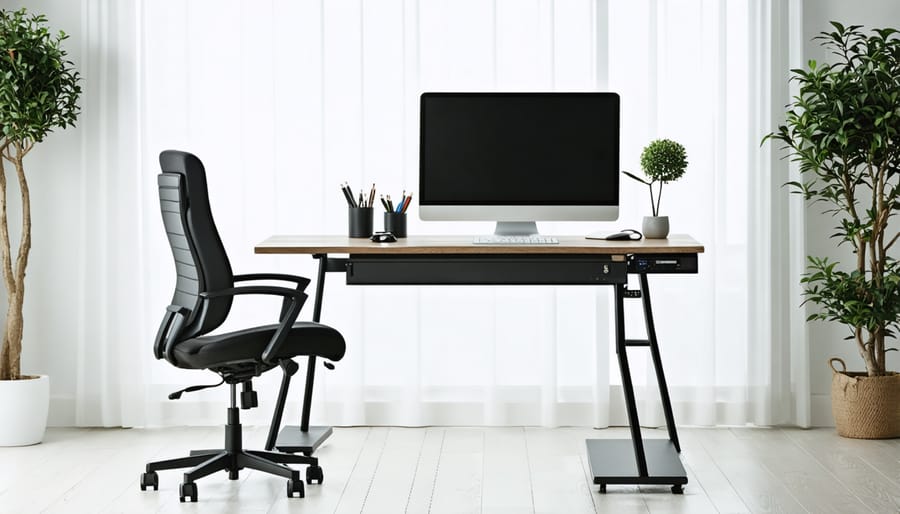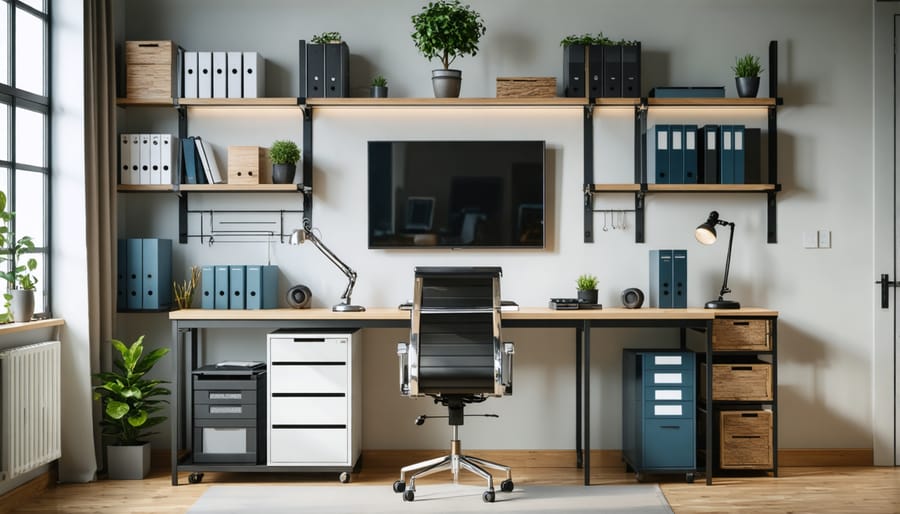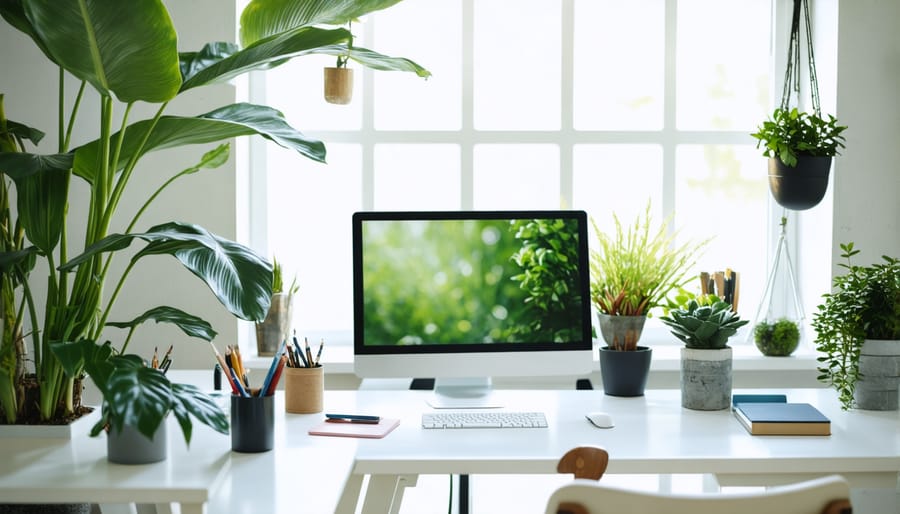Transform any space into a productivity powerhouse by strategically designing your workspace with purpose and intention. Whether you’re working remotely from home or revamping your office environment, creating an efficient workspace directly impacts your focus, creativity, and daily output.
Start by positioning your desk near natural light and away from high-traffic areas to minimize distractions. Incorporate ergonomic furniture that supports proper posture and reduces physical strain during long work sessions. Organize your tools and equipment using the “zones” concept—keeping frequently used items within arm’s reach and less essential materials stored away but easily accessible.
A well-designed workspace isn’t just about functionality—it’s an investment in your professional success and personal wellbeing. By thoughtfully arranging your work area, implementing smart storage solutions, and maintaining a clutter-free environment, you create a foundation for enhanced productivity and job satisfaction. Let’s explore how to craft a workspace that not only meets your practical needs but also inspires your best work every day.
Essential Elements of an Effective Workspace
Ergonomic Furniture Selection
When it comes to creating a comfortable and healthy workspace, selecting the right ergonomic furniture is crucial. Let’s explore how to craft the perfect desk setup that supports your well-being during those long work hours.
Start with a desk that’s at the right height – your forearms should rest parallel to the floor when typing. Look for adjustable-height options if multiple people use the workspace. For most adults, a desk height between 28-30 inches works well, but adjustable standing desks offer the flexibility to switch positions throughout the day.
Your chair is perhaps the most critical piece of furniture. Invest in one with:
– Adjustable seat height and depth
– Lumbar support for your lower back
– Armrests that keep your shoulders relaxed
– A five-wheel base for stability
– Breathable material for comfort
Don’t forget about accessories that enhance ergonomics. A monitor stand or arm helps position your screen at eye level, preventing neck strain. A keyboard tray can help maintain proper wrist positioning, while a footrest can improve circulation and posture when your feet don’t firmly reach the floor.
Remember, even the best ergonomic furniture needs proper adjustment. Take time to fine-tune each piece to your body’s dimensions, and make small adjustments throughout the day as needed. Your body will thank you for the investment in proper ergonomic furniture.

Lighting Solutions
Proper lighting can make or break your workspace, affecting both your productivity and well-being. Start by maximizing natural light, which helps regulate your circadian rhythm and boosts mood. Position your desk near a window, but angle it to prevent glare on your screen. If privacy is a concern, opt for light-filtering window treatments that let sunshine through while maintaining comfort.
For artificial lighting, implement a three-layer approach. Begin with ambient lighting – overhead fixtures that provide general illumination. Choose LED bulbs in the 4000-5000K range for a crisp, daylight-like effect that keeps you alert. Next, add task lighting with an adjustable desk lamp for focused work. Look for options with multiple brightness settings and a flexible neck to direct light exactly where needed.
The final layer is accent lighting, which adds depth and reduces eye strain by eliminating harsh shadows. Consider LED strips behind your monitor for bias lighting, or small uplights in corners to create a welcoming atmosphere. Remember to adjust your lighting throughout the day – brighter in the morning for energy, softer in the evening to ease the transition to rest.
Pro tip: Install dimmer switches for your overhead lights and choose smart bulbs that can adjust color temperature. This allows you to fine-tune your lighting environment as natural light changes and your tasks vary throughout the day.
Space Planning and Layout
Traffic Flow and Accessibility
The way you arrange your furniture can make or break your workspace’s functionality. Start by creating clear pathways that allow you to move freely between different areas of your workspace. A good rule of thumb is to maintain at least 36 inches of clearance for main walkways and 24 inches for secondary paths.
Consider the natural flow of your daily activities when positioning furniture. Your desk should be easily accessible from the entrance, and frequently used items like printers or filing cabinets should be within arm’s reach. Exploring innovative home office layouts can help you maximize both space and efficiency.
Think about the placement of power outlets and cable management solutions when arranging electronics. Nothing disrupts workflow quite like having to stretch across the room to plug in your laptop or dealing with tangled cords. Use cable organizers and consider installing additional outlets if needed.
For shared workspaces, create designated zones that don’t interfere with each other’s traffic patterns. Position collaborative areas near the entrance while keeping focused work zones in quieter corners. Remember to leave enough space around furniture for chairs to pull out comfortably and for cabinet drawers to open fully.
Don’t forget about emergency scenarios – ensure you have a clear path to exits and that fire extinguishers or emergency equipment remain easily accessible. Regular assessment of your layout’s functionality can help you identify and address any flow issues before they become problems.
Storage Solutions
Effective storage solutions are the backbone of a well-organized workspace, helping you maintain focus and boost productivity. Start with vertical storage by installing floating shelves or wall-mounted organizers to maximize unused wall space. These additions not only free up valuable desk surface but also keep essential items within arm’s reach.
Consider implementing a modular storage system that can grow with your needs. Wire grids, pegboards, or adjustable shelving units offer fantastic flexibility and can be customized as your workspace evolves. For a budget-friendly approach, repurpose mason jars or decorative boxes to store smaller items like paper clips, pins, and rubber bands.
Make the most of your desk drawers by using drawer dividers or small containers to create designated spaces for different items. A rotating desk organizer can keep frequently used supplies accessible while maintaining a tidy appearance. Don’t forget about hidden storage opportunities – the space under your desk can accommodate file cabinets or storage ottomans that double as extra seating for visitors.
Cable management is crucial for maintaining order. Use cable clips, cord organizers, or DIY solutions like binder clips to keep wires neat and tangle-free. For paper documents, implement a simple filing system using labeled folders or magazine holders to prevent desktop clutter.
Think vertically with door-mounted organizers or over-the-door hooks for bags, jackets, or equipment. Additionally, consider furniture pieces with built-in storage, such as a desk with multiple drawers or a storage bench that can serve as both seating and storage space. Remember, the key is to create a place for everything while keeping frequently used items easily accessible.

Creating the Right Atmosphere
Color Psychology
Color plays a vital role in how we feel and perform in our workspace. The right color choices can help boost your focus and productivity significantly. Let’s explore how different colors can transform your work environment.
Blue tones are excellent for promoting concentration and mental clarity. Consider incorporating navy or sky blue accents through wall paint, artwork, or accessories. This color is particularly effective in spaces where detailed work is performed.
Green brings balance and harmony, making it perfect for longer work sessions. It’s also easy on the eyes and can reduce visual fatigue. Try adding plants or sage green elements to your workspace for a natural, calming effect.
Yellow sparks creativity and optimism but should be used sparingly. A yellow accent wall or desk accessories can energize your space without becoming overwhelming. For high-energy creative work, this color can be particularly inspiring.
Neutral colors like white, beige, and light gray create a clean, professional foundation. They’re versatile and allow you to switch accent colors as needed. These tones also help reflect light, making your workspace feel more spacious and bright.
Remember to test colors in your space before committing. Lighting can significantly impact how colors appear, so sample different shades at various times of day. Start with smaller color elements if you’re unsure, and gradually build your perfect color palette.
Biophilic Elements
Bringing nature into your workspace isn’t just about aesthetics – it’s a proven way to boost productivity, reduce stress, and enhance creativity. Start by introducing live plants that thrive in indoor conditions, such as peace lilies, snake plants, or potted herbs. These natural air purifiers not only improve air quality but also add a refreshing touch of green to your work area.
Position your desk to maximize natural light exposure, which helps regulate your circadian rhythm and increases energy levels throughout the day. If natural light is limited, consider full-spectrum light bulbs that mimic sunlight. Incorporate natural materials like wooden desk accessories, bamboo organizers, or a cork bulletin board to add organic textures to your space.
Natural patterns and textures can be introduced through wallpaper featuring botanical prints, textile choices with organic motifs, or artwork depicting landscapes. Consider adding a small tabletop water feature – the gentle sound of flowing water can create a calming atmosphere and mask distracting background noise.
Don’t forget about views – if possible, arrange your workspace to face a window with outdoor scenery. If that’s not an option, hang nature photography or create a small vertical garden on your wall. Even small touches like a collection of stones, seashells, or dried branches can help maintain a connection to nature while you work.

Tech Integration and Cable Management
In today’s digital workspace, managing technology efficiently while maintaining a clean aesthetic is crucial. Let’s explore smart solutions that combine functionality with style.
Start by mapping out your power needs. Identify all devices requiring electricity and plan their placement strategically. Consider installing a power strip or surge protector that matches your desk’s color scheme – many modern options come in sleek designs that complement rather than clash with your workspace aesthetic.
Cable management is where the magic happens. Begin with a basic cable tray mounted under your desk to catch loose wires. These trays come in various materials, from mesh metal to clean white plastic, allowing you to choose one that suits your style. For cables that need to travel up to your desk, use cable clips or spiral wire organizers to keep them neat and contained.
Think vertically too. Mount power strips under your desk or on the back of your monitor stand to keep outlets accessible but hidden. Use adhesive cable clips along desk legs or monitor stands to guide wires in clean, straight lines. For a more permanent solution, consider drilling small holes in your desk (if appropriate) for cables to pass through, using grommets for a professional finish.
Wireless technology is your friend. Opt for Bluetooth peripherals where possible to reduce cable clutter. A wireless keyboard, mouse, and headphones can significantly decrease the number of visible wires. If you need to charge these devices, create a dedicated charging station in a drawer or on a shelf.
For those essential cables that must remain visible, choose color-coordinated options or use cable sleeves in complementary colors to your workspace. Some manufacturers now offer braided cables in various colors that can actually enhance your desk’s appearance.
Remember to leave some slack in your cable management system to allow for movement and adjustment of equipment. This flexibility ensures your setup remains functional while maintaining its organized appearance.
Creating your ideal workspace is a journey that combines practicality with personal expression. By following the guidelines we’ve discussed, you can transform any area into a productive and inspiring environment that supports your best work. Remember that the key elements – proper lighting, ergonomic furniture, and thoughtful organization – form the foundation of a successful workspace.
Don’t feel pressured to implement everything at once. Start with the essentials that match your immediate needs and budget, then gradually enhance your space over time. Pay special attention to your daily work patterns and adjust your setup accordingly. Whether you’re working with a dedicated room or a compact corner, the principles remain the same: prioritize comfort, functionality, and personal well-being.
Keep in mind that your workspace should evolve with you. What works today might need adjustment tomorrow, so stay flexible and open to change. Regular maintenance and decluttering will help maintain the efficiency of your setup, while small personal touches can continue to inspire and motivate you.
Most importantly, trust your instincts about what works best for you. While design principles and ergonomic guidelines are valuable, your comfort and productivity are the ultimate measures of success. With these tools and insights at your disposal, you’re well-equipped to create a workspace that not only meets your professional needs but also brings joy to your daily routine.
Take that first step today – even small changes can lead to significant improvements in your work life and overall well-being.
